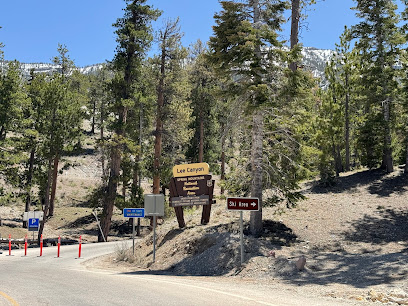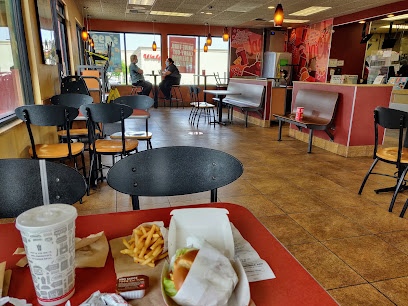
Majestic Mount Charleston: Nevada's Alpine Oasis
Discover the alpine beauty of Mount Charleston, a serene retreat just outside Las Vegas with hiking, skiing, and breathtaking views for an unforgettable adventure.
Nestled just 35 miles northwest of Las Vegas, Mount Charleston offers a refreshing escape from the desert heat. At an elevation of nearly 12,000 feet, this alpine oasis is a haven for nature lovers and adventure seekers alike. The mountain is part of the Spring Mountains National Recreation Area, which boasts over 50 miles of hiking trails, scenic picnic areas, and breathtaking viewpoints. Visitors can explore the diverse flora and fauna, ranging from bristlecone pines to wildflowers, and keep an eye out for wildlife such as wild horses, deer, and a variety of birds. In the winter months, the mountain transforms into a snowy wonderland, attracting skiers and snowboarders to the Lee Canyon ski resort. The cooler temperatures and lush greenery provide a stark contrast to the arid landscapes of the surrounding desert. Whether you're looking for a challenging hike, a relaxing picnic, or simply a scenic drive, Mount Charleston has something for everyone. Don't miss the chance to visit the Mount Charleston Lodge for a cozy meal with stunning views of the mountain. With its unique blend of natural beauty and outdoor activities, Mount Charleston is a must-visit destination for anyone exploring Nevada.
Local tips in Mount Charleston
- Check the weather before you go; temperatures can vary significantly between the base and summit.
- Bring plenty of water and snacks, especially if you plan on hiking.
- Visit during the week to avoid the weekend crowds.
- In winter, ensure your vehicle has chains or snow tires if you're driving to higher elevations.
- Stop by the Spring Mountains Visitor Gateway to get maps and information on current trail conditions.
- Wildlife is abundant; keep a safe distance and do not feed the animals.
Majestic Mount Charleston: Nevada's Alpine Oasis
Nestled just 35 miles northwest of Las Vegas, Mount Charleston offers a refreshing escape from the desert heat. At an elevation of nearly 12,000 feet, this alpine oasis is a haven for nature lovers and adventure seekers alike. The mountain is part of the Spring Mountains National Recreation Area, which boasts over 50 miles of hiking trails, scenic picnic areas, and breathtaking viewpoints. Visitors can explore the diverse flora and fauna, ranging from bristlecone pines to wildflowers, and keep an eye out for wildlife such as wild horses, deer, and a variety of birds. In the winter months, the mountain transforms into a snowy wonderland, attracting skiers and snowboarders to the Lee Canyon ski resort. The cooler temperatures and lush greenery provide a stark contrast to the arid landscapes of the surrounding desert. Whether you're looking for a challenging hike, a relaxing picnic, or simply a scenic drive, Mount Charleston has something for everyone. Don't miss the chance to visit the Mount Charleston Lodge for a cozy meal with stunning views of the mountain. With its unique blend of natural beauty and outdoor activities, Mount Charleston is a must-visit destination for anyone exploring Nevada.
When is the best time to go to Mount Charleston?
Unmissable attractions to see
Palace Station Hotel and Casino
Experience the excitement of Las Vegas at Palace Station Hotel and Casino, your premier resort destination for gaming, dining, and relaxation.

Tuscany Suites & Casino
Discover the ultimate Las Vegas experience at Tuscany Suites & Casino, where luxury meets excitement in a vibrant resort atmosphere.

Peppermill and Fireside Lounge
Discover the retro charm of the Peppermill and Fireside Lounge, an iconic American restaurant and cocktail bar on the Las Vegas Strip.

Pinball Hall of Fame
Discover the magic of pinball at the Pinball Hall of Fame in Las Vegas, where nostalgia meets fun in a unique interactive museum experience.

Bonanza Gift Shop
Explore the vibrant Bonanza Gift Shop in Las Vegas for unique souvenirs, stylish clothing, and a memorable shopping experience.

California Hotel & Casino
Discover the unique blend of Hawaiian hospitality and Las Vegas excitement at the California Hotel & Casino, your gateway to Downtown adventures.

Arte Museum Las Vegas
Explore contemporary art and interactive exhibits at Arte Museum Las Vegas, a vibrant destination celebrating creativity and innovation in the heart of the city.

National Park Express, CHD Inc.
Discover the breathtaking beauty of national parks with National Park Express—your premier travel partner in Las Vegas.

Lee Canyon
Experience the breathtaking beauty and adventure of Lee Canyon, a premier tourist attraction just outside Las Vegas, perfect for outdoor enthusiasts and relaxation.

Lake of Dreams
Experience the enchanting blend of music, light, and water at the Lake of Dreams in Las Vegas, where every evening is a spectacular show.

Virtualis VR
Dive into the world of Virtualis VR in Las Vegas, where immersive technology meets thrilling adventure for an unforgettable experience.

Blue Man Group Las Vegas
Discover the magic of Blue Man Group Las Vegas, where music, humor, and cutting-edge visuals combine for an unforgettable experience.

Desert View Overlook
Discover the stunning Desert View Overlook in Nevada with breathtaking desert vistas, rich history, and unforgettable hiking experiences just outside Las Vegas.

Illuminarium Las Vegas
Discover the enchanting world of Illuminarium Las Vegas, where art and technology converge for an unforgettable immersive experience.

Mary Jane Falls Trailhead
Discover the natural beauty of Mary Jane Falls Trailhead, a stunning hiking area in Mt. Charleston, perfect for outdoor enthusiasts and nature lovers.

Essential places to dine
Lazy Dog Restaurant & Bar
Experience the essence of American cuisine at Lazy Dog Restaurant & Bar in Summerlin - where great food meets warm hospitality.

Olive Garden Italian Restaurant
Experience authentic Italian cuisine at Olive Garden in Las Vegas; where family dining meets rich flavors in a cozy atmosphere.

Sparrow + Wolf
Discover innovative American cuisine at Sparrow + Wolf in Las Vegas, where local ingredients meet creative culinary artistry.

A•Mano Pizza & Italian Cuisine
Experience authentic Italian cuisine at A•Mano Pizza & Italian Cuisine in Las Vegas - where every bite feels like a trip to Italy.

Jack in the Box
Discover affordable fast food delights at Jack in the Box in Las Vegas with an exciting mix of American and Mexican flavors.

Markets, malls and hidden boutiques
Las Vegas North Premium Outlets
Explore over 175 designer outlet stores offering unbeatable discounts in the heart of Las Vegas at the Las Vegas North Premium Outlets.

Miracle Mile Shops
Discover a shopping and entertainment oasis at Miracle Mile Shops, where over 170 stores and diverse dining options await in the heart of Las Vegas.

Grand Canal Shoppes at The Venetian Resort Las Vegas
Discover luxury shopping and exquisite dining at Grand Canal Shoppes in Las Vegas, a unique blend of Venetian charm and modern elegance.

Hershey's Chocolate World
Explore Hershey's Chocolate World in Las Vegas for a delicious journey filled with interactive chocolate experiences and sweet memories.

Omega Mart
Explore Omega Mart in Las Vegas – a unique blend of art, shopping, and surreal experiences that spark imagination and creativity.

Downtown Summerlin
Explore Downtown Summerlin, a vibrant shopping mall in Las Vegas offering diverse retail, dining, and entertainment experiences for every tourist.

Bonanza Gift Shop
Explore Bonanza Gift Shop in Las Vegas for unique souvenirs, clothing, jewelry, and more to capture your unforgettable memories.

Neonopolis
Explore Neonopolis in Las Vegas: A vibrant shopping mall offering entertainment, dining, and unique retail experiences under dazzling neon lights.

Charleston Commons Shopping Center
Explore Charleston Commons Shopping Center in Las Vegas for an unforgettable shopping experience with diverse stores, dining, and lively entertainment.

Living Spaces
Explore Living Spaces in Las Vegas for stylish furniture, home decor, and unique accessories that elevate your living experience.

The Arroyo Market Square
Discover a vibrant shopping and dining experience at The Arroyo Market Square, where retail therapy meets the lively spirit of Las Vegas.

The Retreat on Charleston Peak
Discover the perfect mountain escape at The Retreat on Charleston Peak, where stunning views and cozy comfort meet outdoor adventure.

Barnes & Noble
Explore the literary haven of Barnes & Noble in Las Vegas, where books, coffee, and community come together for a delightful experience.

Charleston Heights Shopping Center
Explore Charleston Heights Shopping Center for a diverse shopping experience in the vibrant heart of Las Vegas, where every shopper finds their treasure.

Whole Foods Market
Explore the vibrant flavors and health-conscious offerings at Whole Foods Market, Las Vegas' premier destination for organic and gourmet foods.

Essential bars & hidden hideouts
Canyon Restaurant & Tavern Bar
Discover Canyon Restaurant & Tavern Bar: A perfect blend of American cuisine and stunning mountain views in Mt. Charleston.

Bristlecone Bar
Discover Bristlecone Bar in Lee Canyon: your relaxing escape with stunning views, refreshing drinks, and inviting atmosphere in the heart of nature.

“The Cliffhanger Bar” at the Retreat on Charleston Peak.
Experience breathtaking views and lively ambiance at The Cliffhanger Bar in Mt. Charleston, a perfect retreat for relaxation and entertainment.

Local Phrases about Mount Charleston
-
- HelloHowdy
[haw-dee] - GoodbyeSee ya
[see yuh] - YesYep
[yep] - NoNah
[nah] - Please/You're welcomePlease/No problem
[pleez/no problem] - Thank youThanks
[thanks] - Excuse me/SorryPardon me/My bad
[par-dun me/my bad] - How are you?How's it goin'?
[hows it goin] - Fine. And you?Just fine. How 'bout you?
[just fine. how bout yuh] - Do you speak English?Ya speak English?
[ya speak english] - I don't understandI ain't gettin' it
[I aint gettin it]
- HelloHowdy
-
- I'd like to see the menu, pleaseCan I take a look at the menu?
[can I take a look at the menu] - I don't eat meatI don't do meat
[I dont do meat] - Cheers!Bottoms up!
[bottoms up] - I would like to pay, pleaseCan I settle up, please
[can I settle up please]
- I'd like to see the menu, pleaseCan I take a look at the menu?
-
- Help!SOS!
[SOS] - Go away!Get lost!
[get lost] - Call the Police!Ring up the cops!
[ring up the cops] - Call a doctor!Get a doc on the line!
[get a doc on the line] - I'm lostI'm all turned around
[im all turned around] - I'm illI'm feelin' under the weather
[im feelin under the weather]
- Help!SOS!
-
- I'd like to buy...I'm lookin' to purchase...
[Im lookin to purchase] - I'm just lookingJust browsin'
[just browsin] - How much is it?What's the damage?
[whats the damage] - That's too expensiveThat's a bit steep
[thats a bit steep] - Can you lower the price?Can ya knock somethin' off?
[can ya knock somethin off]
- I'd like to buy...I'm lookin' to purchase...
-
- What time is it?What's the time?
[whats the time] - It's one o'clockIt's one
[its one] - Half past (10)Ten thirty
[ten thirty] - MorningMornin'
[mornin] - AfternoonAfternoon
[afternoon] - EveningEvenin'
[evenin] - YesterdayYest'day
[yestday] - TodayToday
[today] - TomorrowTomorrah
[tomorrah] - 1One
[one] - 2Two
[two] - 3Three
[three] - 4Four
[four] - 5Five
[five] - 6Six
[six] - 7Seven
[seven] - 8Eight
[eight] - 9Nine
[nine] - 10Ten
[ten]
- What time is it?What's the time?
-
- Where's a/the...?Where's the...?
[wheres the] - What's the address?What's the addy?
[whats the addy] - Can you show me (on the map)?Can you point it out (on the map)?
[can you point it out on the map] - When's the next (bus)?When's the next (bus) comin'?
[whens the next bus comin] - A ticket (to ....)A ticket (to ....)
[a ticket to]
- Where's a/the...?Where's the...?
History of Mount Charleston
-
Mount Charleston, known as Nuvagantu in the Paiute language, has been a significant area for Native American tribes for thousands of years. The Southern Paiute people have a long-standing connection with the Spring Mountains, using the land for hunting, gathering, and spiritual practices. Artifacts such as petroglyphs and tools found in the region provide evidence of their ancient presence and rich cultural heritage.
-
In the late 18th and early 19th centuries, European-American explorers and settlers began to traverse the area. The first documented non-native exploration was by the Spanish, who were searching for trade routes and resources. The Old Spanish Trail, an important trade route between New Mexico and California, passed near the base of the Spring Mountains, bringing with it early explorers and traders who marveled at the rugged beauty of Mount Charleston.
-
Mount Charleston is named after Charleston Peak, the highest point in the Spring Mountains at an elevation of 11,916 feet. The peak was named by John C. Fremont, an American explorer, who led an expedition through the region in the mid-1800s. The name 'Charleston' likely honors Charleston, South Carolina, reflecting the influence of the early settlers and the explorers’ practice of naming new discoveries after familiar places from the East.
-
During the Great Depression in the 1930s, the Civilian Conservation Corps (CCC) played a crucial role in developing the infrastructure of Mount Charleston. The CCC built many of the hiking trails, campgrounds, and facilities that visitors enjoy today. Their work not only provided jobs during a time of economic hardship but also laid the foundation for the area's future as a recreational haven.
-
In 1964, Congress established the Spring Mountains National Recreation Area, which includes Mount Charleston, as part of the Toiyabe National Forest. This designation aimed to protect the unique natural environment and promote outdoor recreation. The area quickly became a popular destination for hiking, skiing, and camping, attracting visitors from Las Vegas and beyond.
-
In recent years, climate change has started to impact the ecosystem of Mount Charleston. Rising temperatures and changing precipitation patterns have affected the flora and fauna, including the rare and endangered Mount Charleston blue butterfly. Conservation efforts are ongoing to mitigate these impacts and preserve the natural beauty and biodiversity of the region.
Mount Charleston Essentials
-
Mount Charleston is located approximately 35 miles northwest of Las Vegas, Nevada. The nearest major airport is McCarran International Airport in Las Vegas. From the airport, you can rent a car or take a shuttle service to Mount Charleston. The drive typically takes about 45 minutes to 1 hour. There are also guided tours that provide transportation from Las Vegas to Mount Charleston.
-
Once in Mount Charleston, the best way to get around is by car. Rental cars are available at McCarran International Airport and in Las Vegas. There are also limited public transportation options, such as the RTC's bus service, which operates in the area. However, for exploring the various trails and scenic spots, having your own vehicle is highly recommended. Taxis and ride-sharing services like Uber and Lyft are also available but may be less convenient for remote areas.
-
The official currency in the United States, including Mount Charleston, is the US Dollar (USD). Credit and debit cards are widely accepted in hotels, restaurants, and shops. ATMs are available in Las Vegas and at some key locations in Mount Charleston, but it is advisable to carry some cash, especially when venturing into more remote areas where electronic payments may not be accepted.
-
Mount Charleston is generally a safe destination for tourists. However, as with any travel location, standard safety precautions should be taken. Avoid hiking alone and always stay on marked trails. Be aware of wildlife and weather conditions, as sudden changes can occur. There are no specific high-crime areas targeting tourists, but it is always best to stay vigilant and secure your belongings.
-
In case of emergency, dial 911 for immediate assistance. The local fire department and police are available to assist in emergencies. The nearest medical facilities are in Las Vegas, so it is advisable to carry a basic first aid kit and any necessary medications. Ensure you have travel insurance that covers medical emergencies and outdoor activities.
-
Fashion: Do wear comfortable and weather-appropriate clothing, including layers, as the temperature can vary greatly. Don't wear flip-flops or open-toed shoes when hiking. Religion: There are no specific religious customs to follow, but always be respectful of others. Public Transport: Do plan ahead if you intend to use public transport, as services are limited. Don't rely solely on public transport for remote areas. Greetings: Do greet people with a friendly hello or wave. A handshake is also acceptable. Eating & Drinking: Do try the local cuisine available at the lodges and restaurants. Don't feed the wildlife, as it can be harmful to them and disrupt natural behaviors.
-
To experience Mount Charleston like a local, visit the Spring Mountains Visitor Gateway for insights into the area's history and ecology. Engage with park rangers who can provide valuable information about trails and wildlife. Don't miss the chance to hike the Mary Jane Falls Trail or the Cathedral Rock Trail for stunning views. For a unique experience, consider staying at the Mount Charleston Lodge and enjoying a meal while taking in the scenic mountain views.
Nearby Cities to Mount Charleston
-
Things To Do in Henderson
-
Things To Do in Boulder City
-
Things To Do in Mesquite
-
Things To Do in Laughlin
-
Things To Do in Kingman
-
Things To Do in St. George
-
Things To Do in Lake Havasu City
-
Things To Do in Joshua Tree
-
Things To Do in Springdale
-
Things To Do in Sequoia National Park
-
Things To Do in Cedar City
-
Things To Do in Palm Springs
-
Things To Do in Mt Carmel
-
Things To Do in Palm Desert
-
Things To Do in Kanab











